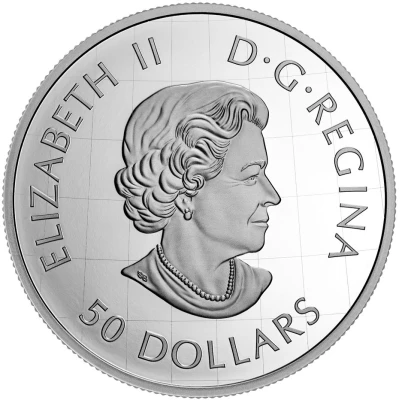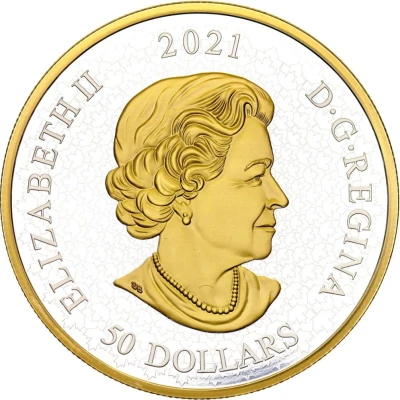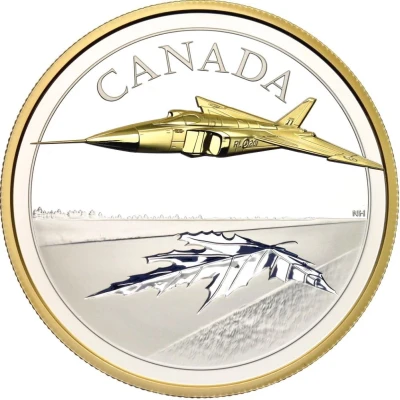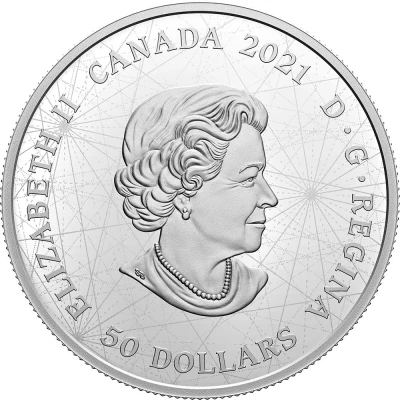
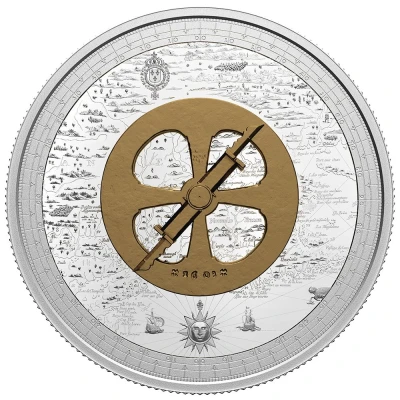

© Power Coin
50 Dollars - Elizabeth II Champlain and the Astrolabe
2021 year| Silver (.9999) (Selective bronze plating) | 157.6 g | 65.25 mm |
| Issuer | Canada |
|---|---|
| Queen | Elizabeth II (1952-2022) |
| Type | Non-circulating coin |
| Year | 2021 |
| Value | 50 Dollars 50 CAD = USD 37 |
| Currency | Dollar (1858-date) |
| Composition | Silver (.9999) (Selective bronze plating) |
| Weight | 157.6 g |
| Diameter | 65.25 mm |
| Shape | Round |
| Technique | Milled (Molded element) |
| Orientation | Medal alignment ↑↑ |
| Updated | 2024-10-04 |
| Numista | N#352496 |
|---|---|
| Rarity index | 97% |
Reverse
The reverse design features a reproduction of the 17th century mariner's astrolabe found near Cobden, Ontario, and popularly associated with French explorer-cartographer Samuel de Champlain. Used to determine latitude, the navigational tool-turned-treasure is cast in silver and bronze plated on this coin; it is backed by an engraved reproduction of Champlain's hand-drawn map of New France (1632), which is framed by the astrolabe's graduated scale.
Edge
Serrated
Comment
AboutThe tale of the 17th century mariner's astrolabe found near Cobden, Ontario, is the inspiration for this 5 oz. pure silver coin. Its reverse features a small-scale reproduction of the lost-then-found astrolabe, cast in silver and bronze plated fixed atop Samuel de Champlain's map of New France (1632). The astrolabe's graduated scale encircles the map, which has been re-created using a mix of traditional and laser engraving that gets all the details right. The end result is a design that perfectly channels the spirit of the era in which the astrolabe was made, used… and lost.
Did you know?
Champlain's "lost" astrolabe. This idea sprang forth in the 19th century after the astrolabe's discovery, but Champlain's detailed account of his 1613 expedition up the Ottawa River contains no mention of a lost navigational instrument. Nevertheless, the mariner's astrolabe bears the date "1603" and lay on a rare portage route used by Champlain; the French explorer would have used an astrolabe in his many voyages at sea and while charting the coasts and waterways of eastern Canada. Another theory holds that the astrolabe could have belonged to missionaries or other travellers who used the same route as Champlain.
The astrolabe was found in August 1867. A 14-year-old boy was helping his father clear trees on the shores of Green Lake (now Astrolabe Lake) near Cobden, Ontario, when he unearthed a brass "disk." It was sold to a steamboat captain for $10, and the mariner's astrolabe passed through several hands before landing in a New York collection. In June 1989, the Canadian government acquired it and conferred it to the Canadian Museum of Civilization (now the Canadian Museum of History), where it proudly resides.
The astrolabe is missing a piece. The Cobden astrolabe is the smallest of the surviving 17th century mariner´s astrolabes and is in excellent condition, except for one missing piece: a small ring to which a weight would be attached in order to steady the instrument. The ring was still intact in an 1879 photograph, so it likely broke off in the late 19th century.
A mariner's astrolabe is a simplified astrolabe. Made of brass or bronze, it was designed for use at sea; its four windows allowed the breezes to pass through while a weight at the bottom kept it steady. It was a common navigational instrument in the 16th and 17th centuries, but only a hundred or so exist today — including the famous one highlighted on this coin.
Of the 100 astrolabes that have survived to this day, at least five are known to be in Canada. They include: a Spanish astrolabe (ca. 1565-1600) found in Red Bay, N.L. and held by Parks Canada; the Cobden astrolabe (1603) presumably made in Honfleur, France, and represented on this coin; two astrolabes – a French one (1617) and a Portuguese one (1638) – discovered at Isle-aux-Morts, N.L. and held at The Rooms in St. John's, N.L.; and a Portuguese one (1632) preserved at the Sulpician Vieux Séminaire in Old Montreal. Another astrolabe (1593) discovered in Cuba by a team of Canadian underwater treasure hunters likely resides in a private collection in Canada.
Packaging
The coin is individually encapsulated and presented in a Royal Canadian Mint-branded clamshell with a black beauty box.
Interesting fact
One interesting fact about this coin is that it features a selective bronze plating, which gives the coin a unique and eye-catching appearance. The use of bronze plating on a silver coin is a distinctive feature that sets this coin apart from other coins in the series.
Price
| Date | Mintage | VG | F | VF | XF | AU | UNC |
|---|---|---|---|---|---|---|---|
| 2021 | 1000 | - | - | - | - | - | - |
Values in the table are based on evaluations by sales realized on Internet platforms. They serve as an indication only for 50 Dollars - Elizabeth II (Champlain and the Astrolabe) 2021 coin.
